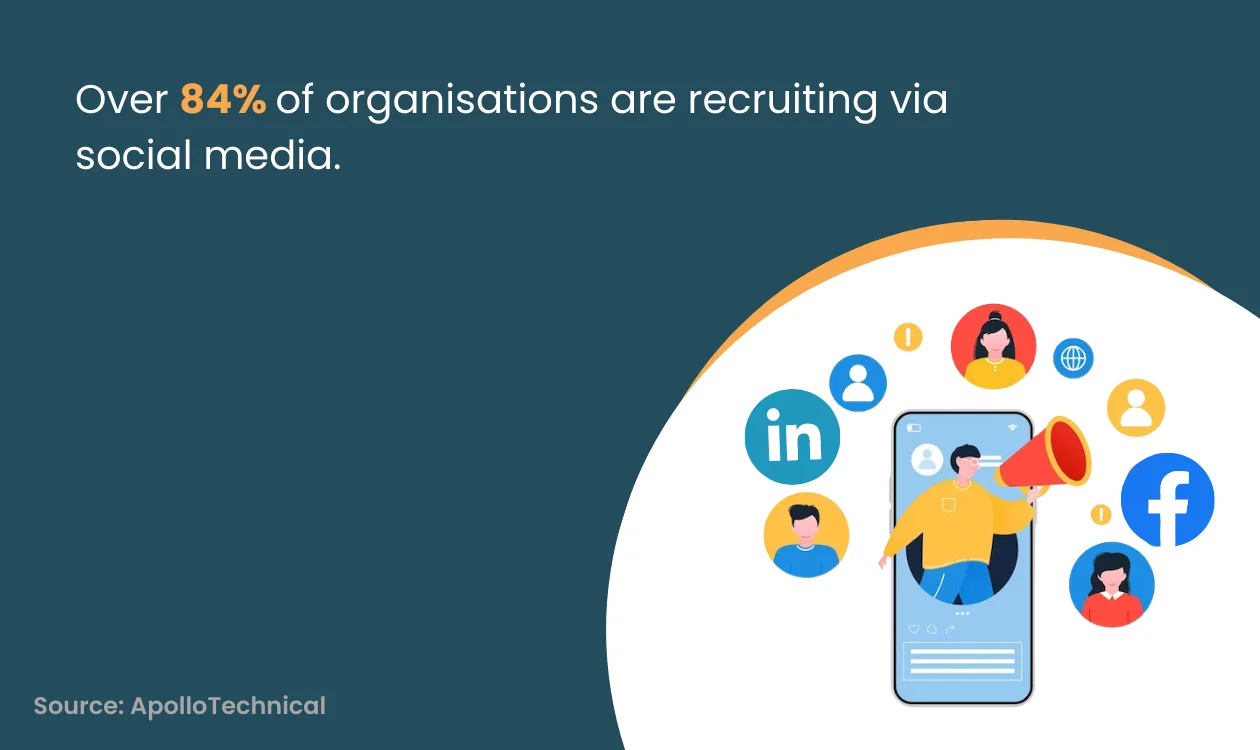Are you one of those who struggle to source talent?
Do you feel like you're spending more time searching for candidates than actually engaging with them? You’re not alone.
In today’s competitive recruitment landscape, crafting an effective candidate-sourcing strategy is crucial. With a talent shortage and a candidate-driven market, finding the perfect match for your open positions has become increasingly challenging.
Worry not because you'll learn about candidate sourcing in this article. Here, you'll get the gist of knowledge to boost your sourcing efforts and practical tips. This helps you to strengthen your candidate sourcing strategy.
You'll get answers to questions like:
- What are the Best Ways to Source Passive Candidates?
- How Do I Plan the Budget for Candidate Sourcing?
- How to source executive-level candidates?
And much more!
Let’s get started!
What is Candidate Sourcing?
Candidate Sourcing, also known as talent sourcing, is the first step in hiring. In this process, recruiters actively search for qualified candidates to fill vacancies. It's about filling the current and future job vacancies within the organisation.
It is a proactive approach to finding and engaging with potential talent for current or future job opportunities. It includes collecting applicant details, screening them beforehand, and building long-lasting relationships.
The main goal of the candidate sourcing process is to create and build a talent pool of qualified candidates. Later on, Hiring managers can select the most suitable candidates from this talent pool for the interviews.
How to Source Candidates?
There are different ways of candidate sourcing. Here are some of the steps recruiters and HR professionals can implement for candidate sourcing.
1. Find Out About Upcoming Vacancies
Initially, you have to identify and list down open roles without waiting for your hiring manager to create a job description for them. Once you know which positions will open up, you can proceed to the next step and save time to filter and find the ideal fit.
2. Research Open Role Requirements
The second step is to develop a thorough understanding of the role requirements from the job descriptions that have been given to you. It will give you more clarity on what skills and qualifications you need to fill the open position.
3. Search for Talent
As you begin the candidate sourcing process, consider various job boards and social media platforms to market open jobs and search for the perfect candidate.
Use your Applicant Tracking System (ATS), which gives you a candidate database management feature to look for a qualified candidate that suits your requirements. Leverage database.
4. Contact candidates
You have shortlisted potential talent (active or passive) that matches your wants and needs for the vacancies. Now it is time to engage with them cold calling or recruitment emails showing them that you are interested in hiring them.
The first communication will give you a headstart to engage with candidates, pique their interest and allure them to apply.
5. Pre-screening Phase
You found your suitable candidate, but wait, is he/she truly a match for what you are looking for?
You can know by conducting a pre-screening process where you check their resume, skills and qualifications. This way, you can short-list them for the next level of the hiring process.
6. Handover Shortlisted Applicants to Managers
You created a list of potential hires that seem fit for the role. Now, it is time to pass them to hiring managers or your client (in case you are an agency) for further assessment.
Sourcing vs Recruiting: What’s the Difference?
Mostly, people, even the recruiter, get confused between these two terms: sourcing and recruiting. The tasks and activities of both terms are a little bit similar, but not entirely. So, let's clarify the difference between sourcing and recruiting.
1. Sourcing Candidates
Sourcing in recruitment is the approach of finding the most suitable talent to fill the present or future open positions. You can perform this via various recruitment marketing platforms.
The people who hold expertise in sourcing are known as Sourcer.
Sourcers find, engage, and build relationships with potential candidates. Here’s what they do on a daily basis.
Responsibilities of Sources
-
Studying the requirements of all the open roles
-
Market open jobs to various job boards, online communities, and social media channels
-
Searching for suitable candidates
-
Emailing or cold-calling candidates
-
Collecting and evaluating resumes
-
Building the employer brand over a period of time
-
Passing on the best of talent to the recruiters
-
Adding exceptional candidates who are not fit at the moment but might be a perfect fit at a later time
-
Collaborating with recruiters to optimise the recruitment process by enhancing the sourcing side
2. Recruiting Candidates
Recruitment is the process of screening, selecting, and appointing candidates through an interview process. Hence, recruiting is an end-to-end process in which a number of stages are executed by the recruiters or hiring managers.
Responsibilities of Recruiters
-
Providing feedback on the quality of sourced talent
-
Scheduling interviews by cooperating with candidates and hiring managers
-
Effectively engaging and communicating with the applicants throughout the recruitment process
-
Explain and describe in-depth the open position to the potential candidates.
-
Conduct background reference checks on potential candidates
-
Maintain the candidate pipeline and increase the value of the talent pool
-
Manage and work with Recruitment CRM Software and ATS
-
Improve the value of the employer brand
9 Creative Ways to Source Candidates
Candidate sourcing is an initial crucial step in the recruiting process. Also, It enables you to regulate your talent pipeline and start discussions with the candidate you truly want. Attracting top talent is essential to the future of the company.
To source a candidate, you need to gather important candidate information and if their skills match the job. Reach out to candidates, inform them about job opportunities, and establish lasting relationships.
Below are some methods that recruiters can use to source candidates.
1. Candidate Sourcing Using Social Media
Social media is one of the methods used by sources and recruiters to source candidates. They use it to narrow their search and identify qualified candidates faster.
You can source candidates through different social media platforms such as Facebook, Twitter, LinkedIn, and so on. Among these, LinkedIn has become an extremely popular social media site in recent times for job hunting.
Here are the most common ways to source candidates via social media.
- Promote a positive work culture that strengthens your employer's brand
- Job posting on various channels
- Identify the channels that match your candidate's persona
- Run targeted job ad campaigns
- Participate in conversations in groups and communities
- Post Value-adding content to attract a wider pool of talent
2. Talent Sourcing via Recruiter Network
Finding skilled people through a network of recruiters has a lot of advantages. It means better-quality hires, quicker recruitment, spending less money, and higher retention rates. A survey by LinkedIn Talent Research found that around 56% of professional recruiters depend on their network to hire new talent.
Therefore, recruiters always have a wide range of networks with clients and candidates too. Their huge network is undoubtedly a great source of candidates. They generally attend recruitment conferences and events to connect with other recruiters. This connection-building helps them in future recruitment.
Moreover, good networking can decrease the time and effort required to find, assess, and interview candidates.
3. Find Potential Talent Through Candidate Database
An Applicant Tracking System (ATS) stores applicants’ profiles who have applied for the jobs. This database can be used to find candidates by using filters like skills, hiring stage, position and application date.
Therefore, recruiters diligently maintain a candidate database. They use this data well when there are new job openings arise. Regularly checking the database enables them to source candidates efficiently, ensuring a seamless and targeted hiring process for the company.
4. Sourcing via Campus Recruitment
According to the survey by Zety, sourcing candidates from the campus will increase companies' brand value by up to 31%.
Recruiters can collaborate with different Universities and conduct campus recruitment to source freshers and entry-level employees. These candidates have adapted to modern technology and are eager to learn new things that come their way.
Moreover, chances are higher that they can join immediately. So it will be easy to onboard them quickly. Also, as you are getting them through the Universities, you would be carefree about losing candidates halfway.
5. Candidate Sourcing Through Employee Referrals
Currently, this is one of the most effective sourcing procedures that never really gets old because it is incredibly useful. Hence, numerous companies have effectively executed employee referral programs. This way, they expand their talent pool 10X through the employees' network or employee referral program.
Employee referral is a great way to reduce sourcing and recruitment costs on advertising, recruiting tools. These referrals will likely be sourced via word-of-mouth, personal connections, and existing platforms.
Also, candidates hired from referrals tend to stay longer in the company and perform better in their jobs. Because they have a higher level of commitment and satisfaction.
You can compensate your employees with some referral rewards. Giving a referral reward to your existing staff is an exceptionally proficient sourcing technique.
Also, your current employees realise what type of candidates you are searching for. Permitting them to prescribe candidates to you. It will add a channel to your candidate shortlisting process, and this is because your workers will refer just those candidates who fit well in your workplace.
Finding the perfect candidate would be a piece of cake by implementing this candidate sourcing process.
6. Candidate Sourcing Through Online Job Postings
According to the survey by Zety found that 58% of job seekers are looking online for a job. Hence, promoting your jobs on online platforms for various roles is a great candidate sourcing strategy.
These job boards not only show your jobs on their portal but also add them to their employment alert emails and bulletins. Your company's profiles’ jobs section could draw in a lot of active job seekers.
This way of posting job ads works really well to bring in top-notch talent who are actively seeking job opportunities.
7. Candidate Sourcing Within the Company
Finding talent within your own company has many advantages. It helps employees grow, makes them want to stay, and lets you use their skills and knowledge effectively.
To conduct Internal candidate sourcing, you can post jobs internally. Make a plan to prepare them for important leadership positions in the future.
Through this, you can meet people from different departments. This can lead you to find talent with diverse skill sets and experiences who have already adapted to your company culture.
With this strategy, the company does not have to invest their time and money in recruitment agencies. The top talent is already there inside the organisation.
8. Offline Candidate Sourcing Techniques
Online recruitment platforms are undoubtedly effective in boosting candidate engagement, while offline recruiting efforts remain strong and influential.
Attending recruitment and career fair events and meeting people in person is an effective way to find new candidates. Attend industry-specific conferences or organise meetups to connect with desired individuals.
Meeting in person makes it less competitive and more likely that candidates will reply to messages afterwards. Encourage team members to attend events to identify potential candidates actively. Candidate sourcing thrives when it becomes a collaborative effort.
9. Faster Candidate Sourcing by Creating a Strong Employer Brand
A strong employer brand is a highly powerful talent acquisition tool for recruiters and hiring managers. It can significantly boost the candidate sourcing process by attracting top talent and increasing the candidate pool of qualified individuals.
Hence, you must use various networking and communication channels, such as social media and career pages. There, you can showcase the amazing perks, benefits, positive company culture, etc.
In addition, you have to make sure to provide a positive candidate experience. If you provide them value, it'll positively affect your employer's brand value.
What are the Best Ways to Source Passive Candidates?
Passive candidates are not actively looking for an opportunity, so it is hard to find them and convince them to work for your organisation. You need to catch their attention in creative ways.
1. Personalise Your Communication
Let’s be very clear that you can not send generic emails to passive candidates. You have to give a personalised touch to your emails. You need to include information that adds value to a particular recipient.
Craft compelling messages that highlight all the key benefits of your organisation and the professional growth of the open role.
2. Leverage Talent Communities
Sourcing passive candidates can be a piece of cake if you create and maintain talent communities regularly on your company's website or via email newsletters.
You can craft valuable content and share it with passive candidates to encourage them to join these talent communities to stay informed about your company and potential job opportunities.
3. Use Boolean Search
Your recruitment team can leverage Boolean Search techniques, which can help them perform more advanced searches on different search engines and social media platforms. It helps your team to find and hire passive candidates with more accuracy.
4. Tap Into Your Employee Network
Even though passive candidates are not looking for any opportunity, the chances are still higher that they will consider a job if they hear it from a friend. So, ask your current employees to refer their friends or mutual connections who have the exact skills you are looking for. You can motivate them by rewarding them with bonuses, extra benefits and compensation.
It will make your passive candidate sourcing much easier, and you will get skilled people with minimal effort.
How to source executive-level candidates?
For sourcing executive-level candidates through an executive search process. It's crucial to employ a strategic approach that taps into both visible and hidden talent pools. Here are some effective methods:
1. Leverage Networking: Utilise professional networks, industry associations, and events to connect with high-level professionals. Executive candidates often engage in these settings, making them ideal for sourcing.
2. Ask for Referral: Ask your current employees, especially those in leadership roles, if they know anyone who would be a good fit. Employee referrals often lead to great hires.
3. Utilise Specialized Job Boards: There are executive job boards and forums specifically tailored for executive roles. Posting vacancies on these platforms can attract applicants who are looking specifically for high-level positions.
4. Consider Internal Mobility: Internal mobility means promoting or transferring current employees to fill higher positions. This approach can save time, reduce hiring risks, and boost morale, as current employees are already familiar with your company’s culture and goals.
Remember, sourcing executive-level talent is a strategic process. By combining these approaches and tailoring your efforts to your specific needs, you can attract top-tier executives who will drive your organisation forward.
4 Key Candidate Sourcing Metrics
In your opinion, you think you have done a great job of finding and shortlisting those potential matches. You gave the list to the manager for further proceeding.
But what is the ratio of your candidates converted into employees? How do you measure your Candidate sourcing effectiveness? Here are crucial candidate sourcing metrics you need to track to analyse your success.
1. Sourcing Channel Effectiveness
This crucial metric will let you know the best sourcing channels for recruitment, which are bringing the most qualified and suitable candidates for particular open roles. Hence, recruiters and hiring managers can spend their efforts and resources on certain quality channels only. Here is the formula to calculate sourcing channel effectiveness.
Let’s say you get 85 developers from LinkedIn, and you hire 13 people who are the perfect fit for the job. Hence, your sourcing channel efficiency would be 13/85 x 100= 15.29%.
So, next time, you can spend all the money and effort on LinkedIn while filling a position for a sales executive.
2. Cost Per Hire by Source
A survey conducted by LinkedIn found that 40% of companies agree that the quality of hire metric is their top priority. This metric will provide you with an insight into the Return On Investment (ROI) of your investment and efforts in sourcing candidates.
Here is the formula to measure the cost per hire by source:
3. Candidate Conversion Rate
This metric will give you the number of applicants who were invited and completed the application. It will let you know how effective the sourcing channels are and the relevancy of the messaging that is being utilised to attract and engage candidates.
If the conversion rate is higher, then it is the outcome of quality communication and engagement. So, recruiters must check the open rate, clicks, and apply ratio for each sourcing campaign and individual cold recruitment email that has been sent.
4. Sourcing Productivity
It is a measure of all the efforts your recruitment team is putting in and the result thereof.
To calculate this sourcing metric, you can consider parameters such as the number of sourcing emails sent to make the initial conversion, cold calling, pre-screening efforts, and LinkedIn outreach and what outcome these efforts have generated.
You can track such activities your hiring team is carrying out on a weekly or monthly basis. For instance, if a team member sends an initial email to 80 possible applicants, and 20 of those individuals respond, then it would be 25%. That is how you can measure sourcing productivity for other productivity sourcing metrics.
Candidate Sourcing with ATS: Benefits Sourcers Get
There are plenty of different places online that sources can use to find relevant candidates. You can use ATS to effectively manage and streamline all of your sourcing in a single place.
Here are some of the key benefits of using ATS to generate candidates from a variety of sources.
-
With ATS, one can quickly and effectively post open jobs across all the job boards and social media channels with just a single click. It saves time for the team.
-
You can build a diverse talent pipeline by archiving the most qualified profiles.
-
Your conversations with potential candidates will be centralised, which your other sourcers can refer to at any time.
-
Track and analyse job posting status within the Candidate Tracking System.
-
ATS enable a collaborative sourcing process. You can make informative decisions, view applicants’ profiles, and leave comments for other team members.
-
Optimise your sourcing efforts with reports and recruitment analytics features. This makes data-driven recruitment decisions and enhances hiring workflow.
- Additionally, executive ATS software streamlines the identification and engagement of top-tier executive talent, integrating advanced search tools and executive-specific sourcing functionalities.
How Do I Plan the Budget for Candidate Sourcing?
To decide your recruitment budget for candidate sourcing, you need to consider different aspects.
Here is the roadmap you can implement to set a budget for conducting your candidate sourcing process.
Step 1: Define Sourcing and Recruitment Goals
First thing first, identify your hiring needs and goals. Determine the number of candidates you want to hire for each open position within the organisation. It will give you clarity on the number of candidates you need to source and the required resources for that.
Step 2: Measure Your Primary Sourcing Costs
In this step, consider how much it costs to advertise job openings on job boards. Also, consider the hard work that in-house recruiters and sourcers have to put in. You can take a reference from previous costs to estimate the basic sourcing cost you require.
Step 3: Predict Fixed Costs for Candidate Sourcing
For this step, consider all the factors for which you need to pay a fixed amount. For example, the cost of attending career fairs, partnerships with universities and institutions.
Step 4: Calculate Technology Costs for Sourcing
This includes the recruitment technology you require for sourcing potential candidates. Which includes an Applicant Tracking System and recruitment advertising platform like LinkedIn Recruiter. You can consider all the technology-related expenses that you need to find candidates.
Step 5: Include Additional Costs for Sourcing Candidates
This last step of budget planning for candidate sourcing requires you to calculate miscellaneous costs for activities like career site enhancement, content creation, and employee referral program bonuses.
Why Choose iSmartRecruit to Source the Best Talent?
iSmartRecruit offers advanced features to help you streamline the talent-sourcing process. Let’s see how iSmartRecruit’s AI Recruitment Software makes your candidate sourcing process ten times faster and better.
1. Job Posting with Just a Click
Easily find the top talent faster by marketing all of your open positions on different platforms. It'll be free and paid job boards, social media sites, and online platforms with just a click. This way, you can achieve maximum reach and higher visibility. That ultimately attracts the best candidates from all over the world.
2. Sourcing Analytics
This powerful feature provides valuable information and data-driven data on your sourcing efforts. In addition, recruiters will get information on which sourcing channel is providing the best candidates for a particular role by using this feature.
3. Effective Social Sourcing
iSmartRecruit’s integration with social media platforms like LinkedIn, Facebook, and Twitter. Which enables you to import candidate profiles, track interactions, and share job openings across social networks.
4. Employee Referral Management Portal
Now, simplifying and managing your employee referral management is way easier with iSmartRecruit! It makes it simpler for your current employees to refer potential candidates for job openings. By using the portal, you can track referral status, and employees get updates on the progress of referred candidates.
5. Run Email Marketing Campaign Smoothly
By using our ATS, you can easily create, schedule, and send targeted email campaigns. This helps connect better with candidates, nurture talent pools, and inform them about job openings in the company.
6. Create Customise Career Pages
With career website integration, you can create a personalised career page. Through this page, you can showcase your company's vision, mission, culture, and values. This makes your company more attractive to people looking for jobs.
FAQs: Candidate Sourcing
Find your answers to the most frequently asked questions related to candidate sourcing. This will not only help you build strategies but also attract active and passive candidates efficiently.
1. How Much Time Should I Spend on Sourcing?
Well, the time you should spend on candidate sourcing depends on specific roles and hiring volume. It also depends on which recruitment tools you are using. It's important to keep a good balance between sourcing new talent to hire and doing other hiring jobs. This helps you work better and get things done faster.
2. How Does Sourcing Affect Recruiting?
Candidate sourcing is an essential part of an organisation’s hiring strategy. It decreases time-to-fill as the pre-screening has already been conducted. It helps recruiters and sourcers to build robust pipelines to cover present and future requirements. Also, it will help you hire diverse candidates who are highly qualified for the job.
3. What is Candidate Sourcing Software?
Candidate Sourcing Software helps sourcers find, assess, and schedule interviews with applicants. Also, you can post open jobs on social media channels, job boards, and other online networking platforms with just a single click.
With robust candidate-sourcing software, recruiters can create a personalised career page easily.
4. What is a Sourcing Specialist?
Sourcing specialists are recruitment professionals who only conduct sourcing for organisations. They figure out what they'll need in the future, create a good plan for finding people, and contact those who might be the right fit for the job. This way, they create a diverse talent pool and measure their sourcing efforts to optimise the overall process.
5. What is Social Sourcing?
Social sourcing means using social media like LinkedIn to find, attract, and engage with candidates. These candidates are those who are an accurate fit for the organisation's current or future vacancies.
By using social media, you can collect candidate information (resume and work sample), reach out to them, and engage. On the platform, you can inform those potential candidates, about relevant job openings.
.
.
.
Want help with conducting sourcing tasks efficiently? If so, then book a free demo.
See how our Applicant Tracking System (ATS) can help you streamline your recruitment process.






_(1).webp.dat)
_(1).webp.dat)

_(2).webp.dat)
.webp.dat)
.webp.dat)




